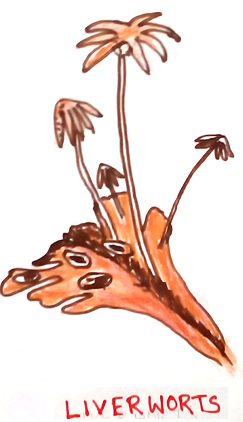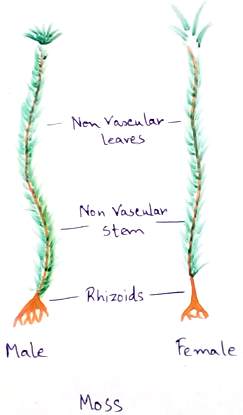Bryophytes
Bryophyte are the plants belonging to the class where well defined root system is absent and root like structure rhizoids and present and leaf like structure are present.
Characteristics of bryophyte are:
1. It is the first terrestrial plant to be grown in damp and shady habitats.
2. They are called terrestrial amphibian’s means amphibians of plant kingdom because they need a moist soil surface for swimming of their sperms and supply of water to all parts of the body. Male gametes are flagellate.
3. Dominant phase is free living thallus gametophyte which does not possess vascular tissues.
4. Absent of proper root as rhizoid is present in place of root for fixation of plant.
5. Sex organs are – jacketed and multicellular male antheridium and female archegonium. Archegonium is flask shaped with 5-6 rowed tubular neck and broader single to multi- walled venter. Venter contains a nonmotile oosphere. Sexual reproduction is oogamous.
6. Fertilization produces an embryo.
7. Sporophytic generation is called sporogony. It is never independent but is parasitic over the gametophyte.
8. Vegetative reproduction occurs by means of fragmentation, adventitious branches, persistent apices, tubers , rhizoid proliferation.
It is of three types –
- Liverworts – Riccia, Merchantia belongs to this category. Bryophytes are generally dorsoventral without a protonema stage. Rhizoids are commonly unicellular. Scales or amphigastria occur. Sporophyte or sporogonium is completely parasitic. Elaters are present in capsule which help in dispersal of spores.
- Hornworts – Porella or Madotheca is a foliosemember of hepaticae . It grows on shaded moist soil, rocks and barks of tree.It’s main axis is branched and prostrate. It bears three rows of leaves, two dorsal and one ventral.Plants are dioecious , elaters are present that help the spores in breaking the capsule and exposed the spores. Sporophyte consist of foot, seta and capsule. Capsule wall is derived from amphithecium.
- Mosses - The bryophytes which are folios with radial symmetry, multicellular rhizoids and a protonema stage in life cycle. Sex organs generally occurs in cluster at the tip of stem branches. Sporophyte or sporogonium contain assimilator tissue, a central columella, peristome. A juvenile filamentous stage which is called protonema occurs in life cycle. Leaves and stems of mosses are not homologous to those of vascular plants because of being gametophytic. Examples of mosses are –funaria, polytrichum, sphagnum etc.
Questions and answers on Bryophytes:
1. What is sporogonium?
In bryophytes the fertilized egg or oospore forms a sporophyte or sporogonium.
2. What is rhizoids?
Rhizoid are unicellular, multicellular colourless branched,substitutefor proper root which found in bryophytes for holding the plant to the soil and absorb mineral.
3. Where is Gemma cup found?
Gemma cup is found in Merchantia which helps in vegetative reproduction.
4. What do you mean by elaters and where is it found?
Elaters are present incapsule for dehiscence of capsule and dispersal of spores. E.g. Riccia and Merchantia.
5. What is calyptra?
Sporophyte which consist of foot, seta and capsule is covered by calyptra.
6. Why bryophytes are called amphibians of plant kingdom?
Bryophytes are called amphibians of plant kingdom because they are the first terrestrial plant to be appear on Earth but there some phases of life cycle are dependent upon water. That is – they require moist soil surface for swimming of their sperms towards egg during sexual reproduction as they are lack of well developed vascular tissues.
Recent Articles
-
What Is Plasma? | Blood Plasma | Proteins | Nutrients | Cholesterol
Nov 07, 25 10:29 AM
Blood is a mobile fluid which is a connective tissue and is derived from the mesoderm like cell any other connective tissue. Colour of blood is reddish and that flows inside the blood vessels by means… -
Disorders of Respiratory System | Tuberculosis | Pleurisy | Emphysema
Oct 28, 25 11:39 PM
Tuberculosis is very common disease and is caused by a type of bacteria called Mycobacterium tuberculosis. This disease causes different trouble in the respiration and infection of several parts of th… -
Regulation of Respiration | Respiratory Centres | Inspiratory Area |
Oct 14, 25 12:13 AM
Respiratory Centre is the area that controls the rate of respiration and it is observed to be located in medulla oblongata and pons. Respiratory Centre has the following will dispersed components like… -
Explain Transport of Gases | External Respiration | Tissue Respiration
Oct 09, 25 11:35 PM
In humans gaseous exchange is completed in the following ways the steps are - External Respiration or Breathing - Breathing in false taking in of Oxygen and giving out of carbon dioxide in the body. M… -
Kind and Number of Teeth | Location of Teeth in Mouth | Care of Teeth
Sep 11, 25 12:52 AM
Kind and Number of Teeth







New! Comments
Have your say about what you just read! Leave me a comment in the box below.